IDEX Online Research: Jewelry Wholesale Census Shows Industry Growth
May 14, 09
While most of the U.S. jewelry industry is losing individual businesses, the wholesale sector is bucking the trend. Currently, there are about 7,700 jewelry wholesalers in the U.S., up over 50 percent over the past two decades from about 5,000 jewelry wholesalers in 1986, based on a blend of data from the Bureau of Labor Statistics (BLS) and the Census Bureau. However, the trend since the beginning of the decade indicates that the number of jewelry wholesalers is waning somewhat.
Typically, the wholesale link in the chain of distribution is the first to disappear when a business segment consolidates. Despite steadily declining numbers of independent specialty jewelers as well as fewer total jewelry stores, the number of businesses which define themselves as “jewelry wholesalers” has continued to rise.
The peak in U.S. jewelry wholesalers occurred in 2002, when there were perhaps as many as 8,700 wholesale jewelers, according to the Census Bureau. At the same time, however, the BLS indicated that there were only 7,100 jewelry wholesalers in America.
There is significant disparity between the BLS census data and the Census Bureau numbers. We believe that’s because wholesalers are an elusive group. Wholesalers don’t need anything other than a telephone, maybe some storage space for a limited amount of jewelry, and not much else, since their primary role is to put a manufacturer together with a retailer. Thus, despite sleuthing by the government census counters, many wholesalers may be missed because they are so small.
The following table summarizes census data for the jewelry wholesale industry in the U.S.
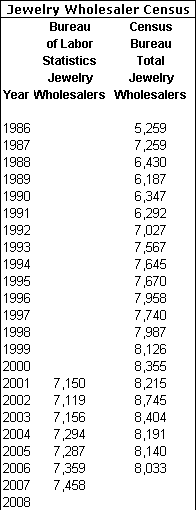
Source: Census Bureau
Small Wholesalers Have Shown Growth
The number of small jewelry wholesalers – defined as those with fewer than five employees – has grown by 65 percent over the past two decades in the U.S. market. In contrast, the number of jewelry wholesalers with 100 or more employees has grown by only 9 percent in the same period.
We believe that many of the small jewelry wholesalers are relatively new to the business. They may represent retail employees who were laid off from chain stores; they may represent employees who decided to start up their own company, after working for a jewelry wholesaler.
The large increase in the number of smaller jewelry wholesalers also illustrates that this segment has low barriers of entry. Further, there are thousands of very small jewelry manufacturers overseas, and those producers don’t have the resources to support their own sales force. As a result, wholesalers step in and serve as the sales force for those small producers of custom jewelry. Therefore, there is continuing strong demand for jewelry wholesalers in the U.S. market.
The graph below summarizes the mix of jewelry wholesalers by total employees for 1986 versus 2006.
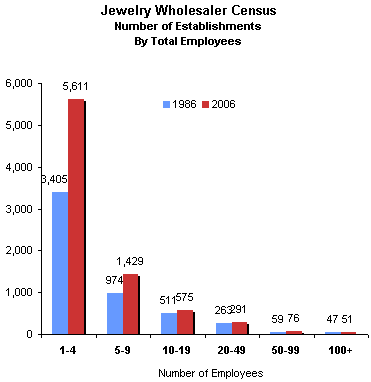
Source: Census Bureau
The table below summarizes the number of jewelry wholesalers by total employees since 1986.
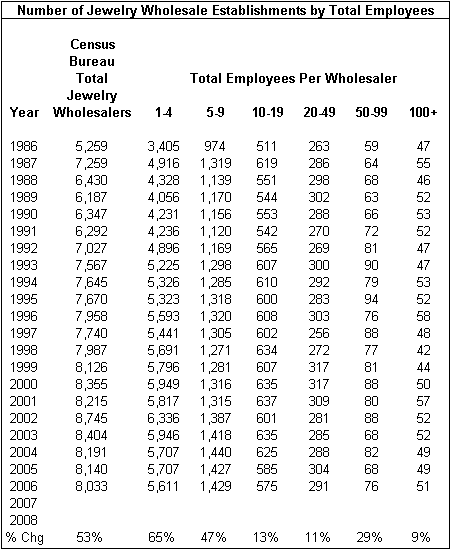
Source: Census Bureau
Wholesale Industry Employment Up; Payrolls Soar
Over the past two decades, the number of people involved in the U.S. jewelry wholesale industry has risen by about 30 percent. In the same period, total payroll dollars have spiked by two-and-one half times. In 1986, the total jewelry wholesale payroll was just over $900 million. By 2006 (the latest data available), payrolls had risen to nearly $2.4 billion.
Since the beginning of this decade, the number of employees involved in jewelry wholesaling has risen by a scant 2 percent, but their pay has risen by about 25 percent.
The table below summarizes employment and payroll trends in the U.S. jewelry wholesale segment.
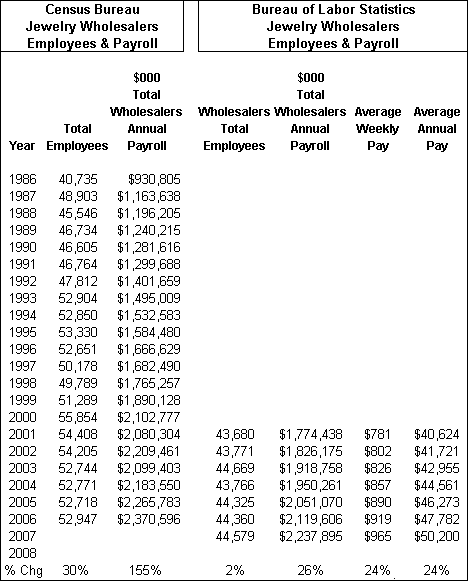
Source: Census Bureau
The Future of Wholesalers: Safe Until The Industry Consolidates
Traditionally, wholesalers provided a service to independent jewelers: they would procure merchandise in bulk from manufacturers, and send as few as one piece to a retail jeweler. Wholesalers also provided advertising support, perhaps extended payment terms and functioned as an independent jeweler’s buying organization. For the manufacturer, wholesalers were their eyes and ears in the market. The helped manufacturers with design, and kept them abreast of the latest market trends.
In addition, as mentioned earlier, the overseas jewelry manufacturing sector is highly fragmented. Many of those small producers cannot afford their own sales force. By utilizing jewelry wholesalers, they can obtain distribution into the American market.
In an industry that is still as fragmented as the jewelry industry, wholesalers continue to play an important role. However, as the number of independent jewelers diminishes, wholesalers could become a vanishing breed, just as they have in the hardware/home center business, consumer electronics, office supplies and almost every other major retail category. When retailers become large, they no longer need a wholesaler to help them source products and deal with manufacturers.
But the need for wholesalers by small overseas producers won’t diminish near term. These small jewelry producers need on-site representation in the American market. This is an ongoing challenge that has captured the attention of some overseas governments. Unfortunately, little progress has been made to overcome this challenge.
Jewelers Board of Trade Data Differs
Normally, we like to have at least three sources to confirm our research data. There are three sources for the jewelry wholesale census, but one source is substantially different from the other two. The Jewelers Board of Trade, which is the credit watch-dog of the industry, includes about 4,500 wholesalers in its census, only about 60 percent of the number claimed by the Bureau of Labor Statistics and the Census Bureau.
We have reviewed the JBT data with it staff, and we have concluded that the government uses different definitions to describe wholesalers versus manufacturers. While JBT’s wholesaler census is roughly 60 percent the government census, its manufacturing census is substantially more than the government census. When the wholesale and manufacturing census numbers are added together for both the JBT and the government, the numbers are much closer together. Overall, however, the JBT aggregate census of wholesalers and manufacturers is lower than the government census due to two key factors: 1) JBT counts a business entity as one, no matter how many physical facilities they have (the government counts each physical address); and 2) JBT does not claim to list 100 percent of the businesses involved in the jewelry industry in the U.S.
The following table illustrates the disparity between the JBT wholesale census data and the average of the two government bureaus that track census information.
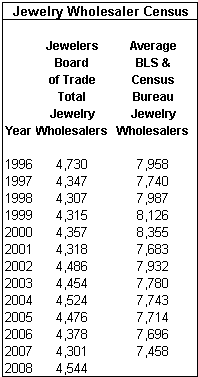
Source: Census Bureau
New Data Expected Late Summer
U.S. government census data lags by up to two years or more, in some cases. We are expecting 2007 business census data to become available in August. At that time, we will update these tables.